 Although we had already seen Vittorio Emanuel II's monument it is here that his body is buried. The Pantheon, the 'best preserved' of Rome's ancient buildings, has survived 20 centuries of war, plunder, pillage and the occasional remodel. It was originally built, and looked very different, as a Roman Temple to 'pan theos'- meaning all the gods- in 20 to 25 CE.
Although we had already seen Vittorio Emanuel II's monument it is here that his body is buried. The Pantheon, the 'best preserved' of Rome's ancient buildings, has survived 20 centuries of war, plunder, pillage and the occasional remodel. It was originally built, and looked very different, as a Roman Temple to 'pan theos'- meaning all the gods- in 20 to 25 CE.
The portico is the only part left of the rectangular building, built by Marcus Vipsanius Agrippa, son-in-law of Augustus, first Emperor of Rome, that would look anything like it did back then. Sometime between 118 and 125 CE Haddrian rebuilt the structure that can still, almost two thousand years later, claim to be the largest unreinforced dome in the world.

The giant dome that dominates the interior quite simply takes your breath away. At 43m in around the dome completely dominates the inside of the building, in fact once inside it becomes the building. They say if you could find a soccer ball(that's football for those of you not familiar with Kiwispeak) big enough it would fit exactly in the perfectly round space- for the distance from the floor to the top of the dome is exactly equal to its diameter.

The recesses in the dome, apart from making it lighter on the eye, reduce it's actual weight as does the pumice cement used closer to the middle. The oculus, the hole in the top of the dome, is the main light source for the interior and yes sometimes it rains inside too and slips down the cleverly slanted floor into unobtrusive drains.

Converted into a Christian church in the 17th century and dedicated to the Virgin Mary,the main altar holds a 7th century icon featuring the Madonna and child. The apse above it features a golden mosaic decorated with crosses.
 There are, in fact, many examples of the Madonna and child found in other recesses around the churches interior.
There are, in fact, many examples of the Madonna and child found in other recesses around the churches interior.
Detail from another Baroque Madonna and child probably an 'adoration' where Mary is painted with the baby Jesus in the middle of a group of, in this case, either the shepherds or magi I can't remember which. (It would be cool to have a place to put wee notes on the camera next to each picture sometimes dont you think?)
 Another Madonna and child above the tomb of the artist Raphael.
Another Madonna and child above the tomb of the artist Raphael.
Madonna of the Girdle and St Nicholas of Bari painted in 1686 by an unknown artist.

A sculpture by Il Lorenzone of St Anne and the Blessed Virgin.
After visiting the Pantheon in 2005 a New Zealand writer and expert in timekeeping suggested the building could have a secret identity as a giant ancient sundial of sorts. He had observed, apart from the path it traces around the dome, down the wall and across the floor during the year, that the light that comes through the oculus during the two equinoxes, in March and September, strikes the grille directly above the Pantheon's huge heavy northern doors. The grille allows just a slither to escape and mark a spot on the courtyard in front. Coincidence? Maybe not if you take into account the perfect celestial hemisphere the dome forms inside, an integrated actualisation of the Greeks mathematically conceptualized theory of the cosmos, in a building that bears a remarkable resemblance to the general composition of sundials of the time albeit on a majestic scale. It's name, Pantheon meaning 'all of the gods', adds further weight to the theory that it at least presents a mirror image of the home of the gods especially during the equinox when the sun is on the celestial equator (where Earth's equator would lie if projected into space), the most stable part of the sky and thus the assumed home of the myriad of Greek and Roman gods.
The building certainly does have a special aura about it and the effort it must have taken to not only design and build such a magnificent dome, that despite its immense size seems to lightly hover on its supporting walls, but to have it centuries later, still stand omnipotent in all its silent grandeur really does inspire awe a reaction I would consider apt for a Heaven on Earth.
In the plaza outside the Pantheon is a fountain topped by an ancient Egyptian obelisk erected by Pope Clement XI.
 The next stop was Trevi Fountain, probably the most famous fountain in Rome. Most of the pictures you see are like this...
The next stop was Trevi Fountain, probably the most famous fountain in Rome. Most of the pictures you see are like this... and I guess I just assumed it would be, like many of the other fountains and 'go-to' sites we had seen in both Rome and Venice, in a sprawlling piazza or at the very least an open space but it's not.
and I guess I just assumed it would be, like many of the other fountains and 'go-to' sites we had seen in both Rome and Venice, in a sprawlling piazza or at the very least an open space but it's not.
Much of the approach to Rome's biggest fountain is like this...

... which pops out at the top left hand corner of this photo.
Oddly familiar in that 'I can't quite place where I've seen you before' kind of way the lavish fountain is a grand 26 meters high and 20 meters wide and has been around since the middle of the 15th century when the tradition of building fountains to mark the end point of an acqueduct was rekindled. The aqueduct it marks, the Acqua Vergine, however, predates the beginning of the Common Era although it was destroyed by invaders in the 6th century. The fountain you see today was finished in 1762 after years of false starts and is now a culmination of many diverted springs rather than the one pure spring that inspired it's legend.
The story goes that a bunch of Roman soldiers were dispatched to find a source of spring water closest to Rome. They were met by a young and beautiful girl who led them to the purest of springs which they christened the 'Acqua Vergine', Virgin water.
Until about 40 years ago visitors would drink the fountain water, some would even collect it for tea.

This is the other side of the fountain...squashed into a tiny space that barely copes with the hordes drawn to the cascading water not the bulging biceps or chiseled abdominals of it's star, Oceanus, but by a story that has compelled everyone from Marylin Monroe to the Olsen twins to do this...

Another well told legend, one that motivated a movie called 'Three coins in the Fountain' (1954), holds that if visitors to the fountain throw a coin (in the movie three women each throw a coin hence the 'three coins'), with your right hand over your left shoulder, into the fountain, they are ensured a return Rome.
Approximately $3500 is thrown into the now heavily chlorinated waters of the Trevi Fountain each day. The coins are collected at night and used to subsidize a supermarket for Rome's poor population.










































